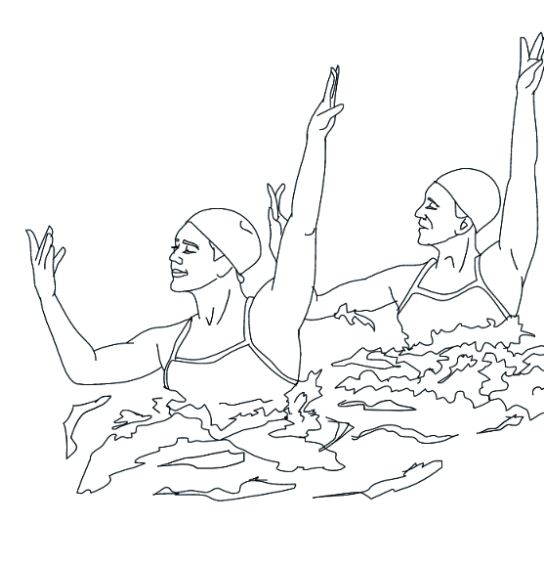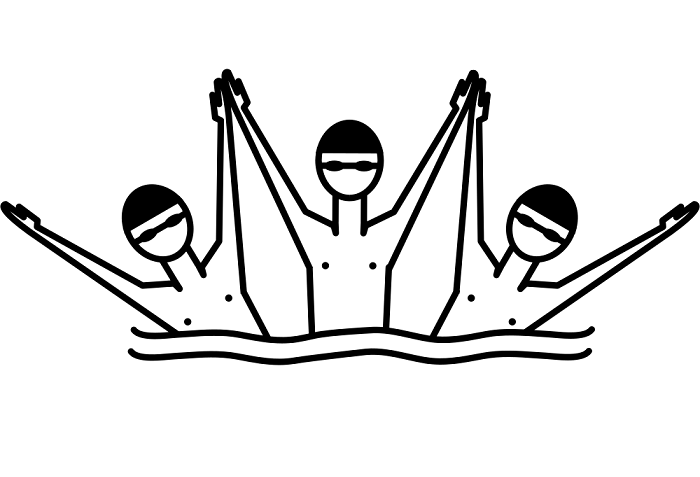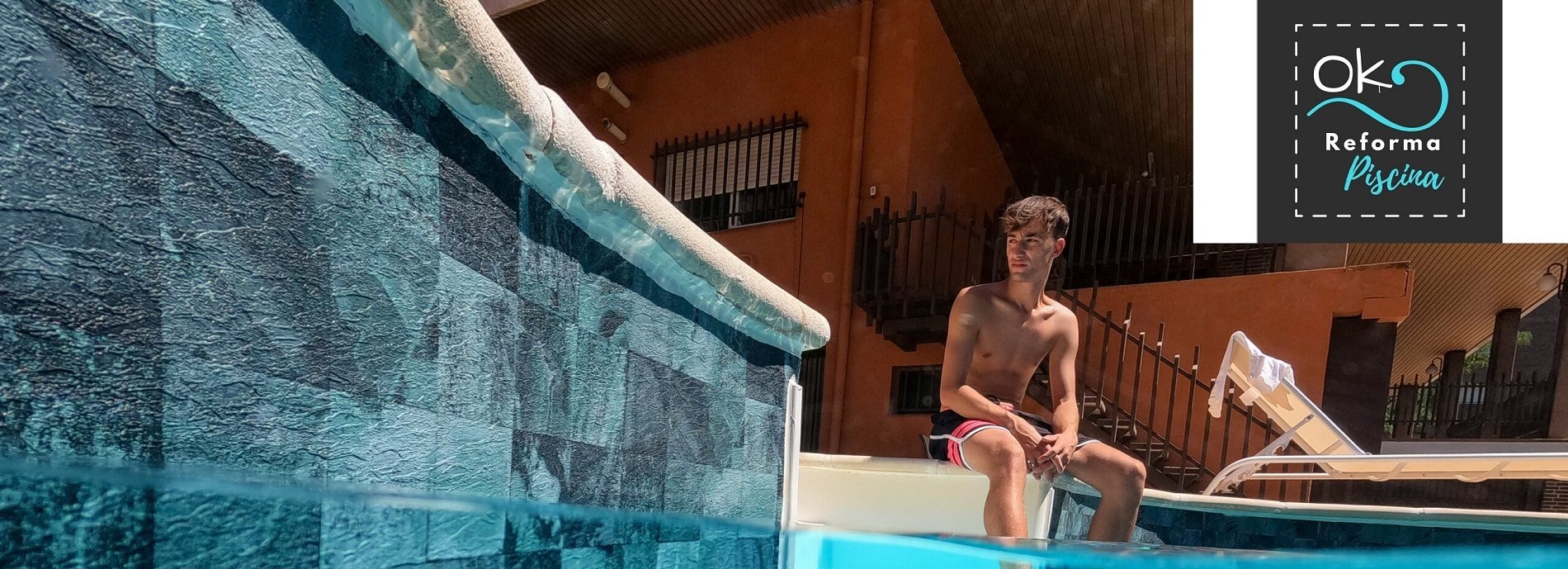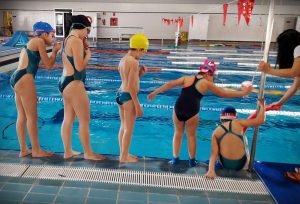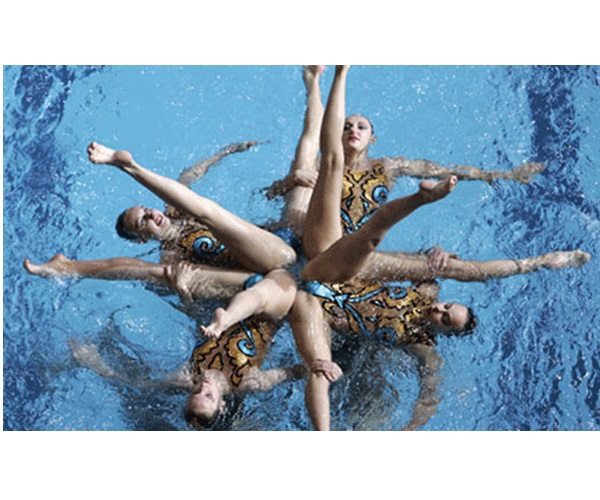
Table of contents of the page
En Ok Pool Reform we expose you one of the pool sports most appreciated and we break it down for you: How to practice synchronized swimming.
What is synchronized swimming

Synchronized swimming what type of sport is it?
What is synchronized swimming
Above all, la Synchronized swimming (I also swim synchronized, Or artistic swimmingIt is a sport derived from swimming based on a form of aquatic ballet consisting of swimmers (both alone, duos, teams or combined, also called combos). which Specifically, they perform choreography with elaborate movements that mix dance, swimming and gymnastics timed to the rhythm of music.
What does synchronized swimming mean?

What is synchronized swimming?
Currently, the Synchronized swimming is made up of womenHowever, in some championships they allow men to enter.
This type of sport makes the aerobic and physical resistance prevail, which together make the routine perform.
Furthermore, it is an exercise that, to the rhythm of music, is performed by the acrobatic figures, both underwater and out. As is known, doing any kind of exercise in water is always beneficial, as it tones every millimeter of the muscles, producing better physical work in the long run.
Synchronized or artistic swimming is a widely recognized sport

Artistic swimming: appreciated sport
La gracefulness of movements, hairsalon of the artist or the singularities of the dresses, which make them a work of art in most cases, make synchronized swimming one of the most beautiful sports to watch.
Artistic swimming video: extreme sport
Fernando Gomollón Bel visits the Casablanca Stadium to discover why science considers synchronized swimming an extreme sport.
General details of synchronized swimming
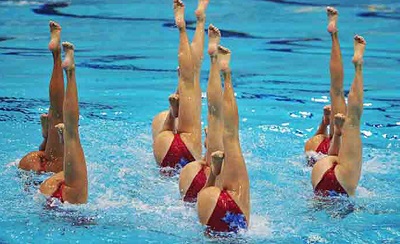
What is synchronized swimming for?
A very complete sport, synchronized swimming is very exhausting and requires great physical strength from its swimmers.
La Synchronized swimming It is a judged discipline that combines gymnastics, dance and swimming. Develops flexibility, endurance, creativity, cardio, concentration and team spirit.
Facts about artistic swimming
Generalities about synchronized swimming
| sports authority | FINA |
|---|---|
| Other names | synchronized, synchronized, synchronized swimming, synchronized swimming, artistic swimming |
| first competition | Europe: Berlin, 1891 America: Montreal,1924 |
| Members per team | 1, 2 or 4 to 8 and 10 (individual, duo, team and combined) |
| Gender | In World Cups and Olympic Games only female. |
| Category | Water sports (aquatic) |
| Place of encounter | Swimming pool (called bucket) Figures: 10x10m plus margins Routines: 12x12m plus margins |
| duration of the encounter | Depending on the type of exercise, category and modality between 2 and 5 minutes. |
| Score format | The jury evaluates the technique, artistic execution/composition and difficulty. |
| Olympic | since 1984. |
Synchronized swimming training for swimmers
High-performance athletes train six to eight hours a day.
They take classes in:
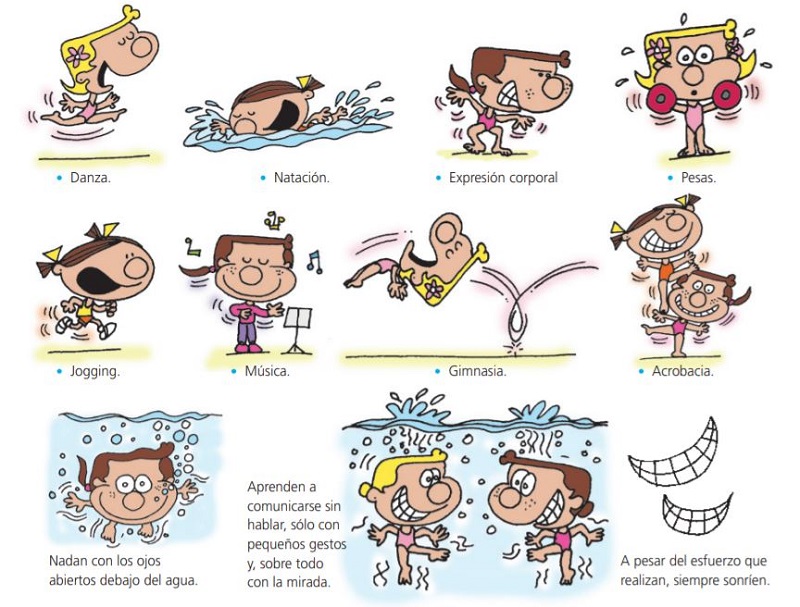
Where is synchronized swimming practiced?
Where to practice artistic swimming
Synchronized swimming is an aquatic sport performed in a pool that is practiced in world championships and Olympic games but only in the female category.
Who can practice synchronized swimming?
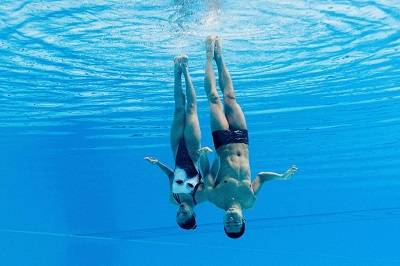
This discipline is mixed, that is, they can practice it both men and women and even now there is a category where compete in pairs, un male and a female. However, there is only feminine modality en World Championships y Olympic Games.
Synchronized swimming excludes men
However, synchronized swimming is governed by sexist regulations that make men are banned of international competitions.
However, in the world swimming championships Kazan in 2015 It was where men were seen competing for the first time, although only in the category of mixed duo (detailed further down this page).
When was swimming an exhibition sport?
Artistic swimming competition
LSynchronized swimming appeared as an exhibition sport in the Olympic Games between 1948 and 1968, and was incorporated as a competitive sport in Los Angeles 1984.
Competition modalities in synchronized swimming
Synchronized swimming competitions
Primarily, in synchronized swimming, different possibilities of competing in the sport are established, such as: competitiveness in solo, duet, team and combined.
When did synchronized swimming become an Olympic sport?

Relatively recent discipline, synchronized swimming became en olympic sport for the first time in Los Angeles 1984, with individual and couples events.
These events also se carried out in the Games Olympic in 1988 in Seoul and in Barcelona in 1992.
Synchronized swimming at the Olympic Games
Who are the most important exponents of synchronized swimming?
The three exponent countries of the Synchronized swimming are:
- Russia, with eight gold medals in Olympic Games.
- United States with five gold, two silver and two bronze medals in the Olympics.
- Canada with three gold medals, four silver and one bronze.
Jjoo synchronized swimming: Medal table by country
- Updated to Tokyo 2020.
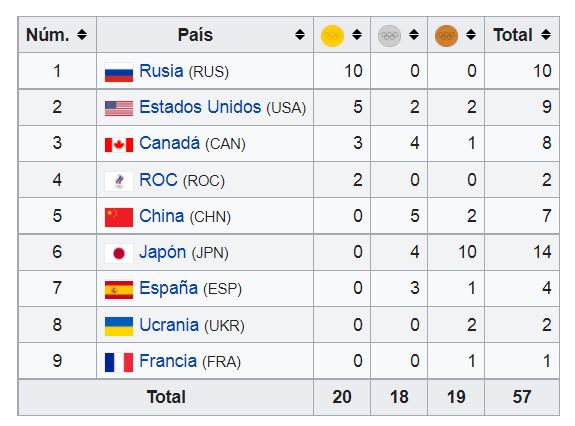
Benefits of synchronized swimming
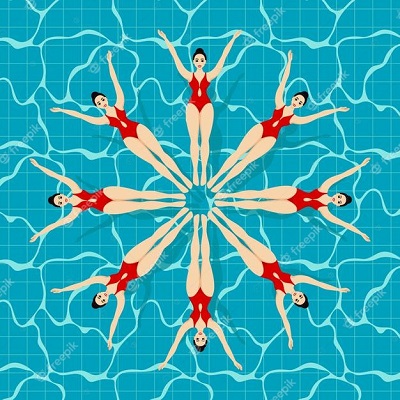
Synchronized swimming: a comprehensive aquatic sport that contributes to the complete development of the person from a motor, cognitive and affective perspective.
Synchronized swimming: a very beautiful activity that requires a multidisciplinary nature
What is synchro or artistic swimming?
Synchronized swimming is a multidisciplinary sporting activity.: swimming, ballet, body expression, musical education, flexibility, bodybuilding.
Synchronized swimming water sport requirements
For this same reason, in synchronized swimming it is strictly necessary to train the following skills: strength, flexibility, physical endurance, art, beauty, coordination, precision, musical sense, artistic expression, lung capacity resistance.
It unites the skills of a swimmer, a water polo player and a dancer, which makes it the most complete female sports specialty.
Benefits of synchronized swimming
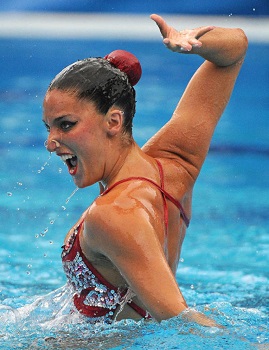
What is synchronized swimming for?
What are the health benefits of artistic swimming?
As a combination of swimming, dance and gymnastics, artistic swimming offers a real variety of activities.
Whether you want to improve your core strength and flexibility, find a creative outlet for choreography and dance, or simply try a new way to have fun and make friends in the water.
It's a great way to stay in shape, and it's not just for women.
Benefits of Synchronized Swimming as a physical-recreational option
Synchronized Swimming is one of the most beautiful sports that exist, valued not only for the way the different movements are performed, but also for the complexity of its actions, which make it a true spectacle.
Next, we give you a list of the benefits in order to situate yourself and then go into detail about each one of them.
Advantages of artistic swimming
- Firstly, it is a sport with low impact on the joints and is of great protection for those people who suffer from osteoarthritis.
- Second, flexibility progress.
- Thirdly, it promotes lung capacity.
- Improves blood flow to the body.
- On the other hand, it strengthens the muscles.
- It also increases resistance.
- In addition, it is an activity with a high calorie burn.
- Likewise, training helps to increase social skills.
- Finally, it helps in case of stress or anxiety and strengthens the mental state.
1st synchronized swimming benefit
Low impact on the joints.

Low impact on the joints.
To be and stay in good physical shape, it is advisable to do sports frequently.
- But sometimes sport can have a negative impact on your body: knee pain, muscle pain, back pain, etc. One of the great advantages of synchronized swimming is its low impact on the joints, since it is practiced in water. Therefore, swimming will give you exercise without affecting your joints.
2nd synchronized swimming benefit
Guaranteed beneficial impact for flexibility

It will even have a positive effect on them by working on their flexibility while strengthening them.
- Studies show that synchronized swimmers are second only to gymnasts in flexibility.
Sport of great help for osteoarthritis
- Apart from the fact that artistic swimming will help you become flexible and agile during all aspects of the sport, whether on land or in the pool, Athletes suffering from arthritis and other related conditions have seen great improvement since they began playing the sport.
- Well, this sport will help you work on the range of your joints and relieve pain.
3nd synchronized swimming benefit
Improves the respiratory system.

Increased aerobic capacity
- Increased aerobic capacity: Tests also show that Synchronized swimmers rank second only to distance runners in aerobic capacity thanks to prolonged periods of breath holding while active contribute to this.
- On average, an artistic swimmer can hold their breath for up to three minutes, although this is usually reduced to just one minute at a time in routines.
- Also, expand your lung capacity can help lung conditions such as asthma.
4nd synchronized swimming benefit
Promotes blood circulation

On the other hand, it is worth mentioning that also It improves blood flow and helps maintain correct blood pressure
5nd synchronized swimming benefit
Strengthens the muscles

Increased muscle strength
- The increase in muscle strength occurs through artistic swimming routines, which can involve a series of turns, splits, pointed toes and more; that is to say, The variety of the routine means you are constantly isolating and exercising individual muscles.
- Likewise, artistic swimmers cannot touch the bottom of the pool for lifts, so they must develop their strength on land to be able to perform gravity-defying lifts.
- In addition to constantly floating in the water while performing gravity-defying moves, keep in mind that when teammates lift each other up, they don't touch the bottom of the pool, so super core strength must be available.
6nd synchronized swimming benefit
Improves stamina

Increased resistance
- While top athletes make the sport look easy, an artistic swimmer's conditioning is extreme as continuous movement increases resistance as athletes perform a full-body workout during each routine.
- To the point that artistic swimmers spend up to six days a week, eight hours a day, perfecting their technique.
- Although at an amateur level, Two hours a week can have a big impact on your endurance through cross training on land and in the pool.
7nd synchronized swimming benefit
Burns a lot of calories
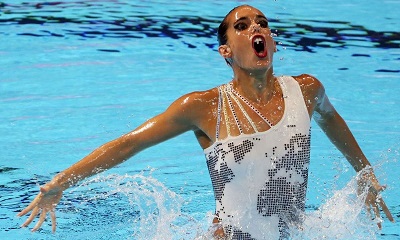
Synchronized swimming is one of the sports that consumes the most energy.
- It is the ideal sport to control weight, of course If you practice it for an hour at a moderate pace, you can burn up to 400 calories, and about 900 if you do it intensely.
8nd synchronized swimming benefit
Gain teamwork skills

Increased confidence and teamwork skills.
- Actually, when we do a team sport that involves interacting with new people of all ages and completely different from each other, which It allows you to develop and increase social skills in general.
9nd synchronized swimming benefit
Produces mental well-being

Works the brain: Learning routines engage the brain to memorize and retain information.
- Keeping the brain active ensures that new neural pathways are created and existing ones remain healthy.
- In the case of synchronized, Every time there is a routine to memorize, the brain is working to remember and retain itApproximately and depending on your involvement, up to three different routines are learned each year.
greater discipline
- The fundamentals of synchronized swimming are to acquire discipline, values of success that we can extrapolate both in the pool and in life.
Eliminate tensions
- Sports in the pool produce endorphins for us through which we will combat possible depression, achieve a good state of mind and achieve psychological health.
- To finish this point, take into consideration that practicing it as a way to improve the quality of life, social insertion, elimination or isolation of vices and harmful habits, occupation and healthy use of free time, is undoubtedly a positive activity. , and that also provides attributes to the practitioners.
10nd synchronized swimming benefit
Recreational synchronized swimming for all ages
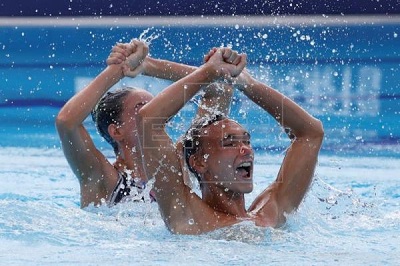
Synchronized swimming can be practiced at any age
- Regardless of whether synchronized swimming is considered an early initiation sport, due to the characteristics it presents, It is highly recommended at the amateur level by all types of people who do not wish to achieve an Olympic goal,
- What is synchronized swimming
- General details of synchronized swimming
- Benefits of synchronized swimming
- Synchronized Swimming Chronology
- Origin and exclusion in men's synchronized swimming
- What is needed to practice synchronized swimming?
- How do you start synchronized swimming classes?
- Basic positions in synchronized swimming
- Basic movements in artistic swimming
- Types of competitions and exercises in synchronized swimming
- Synchronized swimming qualification
- Synchronized swimming with heels
- Synchronized swimming coloring pages
Synchronized Swimming Chronology

Next, we date all the most fundamental facts so that you can later find them in precise chronological order.
Enumeration of the most important events in the history of artistic swimming.
| Year | Site | Event in the history of artistic swimming |
|---|---|---|
| 1891 | Berlin | First competition record in synchronized swimming |
| 1892 | England | Artistic swimming begins to emerge, although it was not known by this name, but the sport was called Artistic Swimming practices or also, Aquatic Ballet. |
| 1892 | Yorkshire | First synchronized swimming event |
| 1896 | Greece | First Olympic Games to include this water sport |
| 1907 | New York | Annette Kellerman is awarded the foundation of synchronized swimming |
| 1908 | London | Creation of the International Amateur Swimming Federation (FINA). |
| 1920 | England, Canada, Holland, Germany, Belgium, France, the United States or Australia. | In 1920 the origin and birth of synchronized swimming synchronously in different swimmers from different countries. At the same time, that same year, the figures they made in the water became known as Ornamental Swimming. |
| 1924 | Canada | The first competition is held of this discipline in the Montreal Amateur Athletic Pool Association. Peg Seller turns out to be the first winner of a synchronized swimming competition. |
| 1926 | Canada and Wales | In Canada the National Championship of figures and styles is organized and in that same period the Welsh Trophy was established which they called Scientific and Full of Grace. |
| 1933 | Chicago | Katherine Curtis organized a water ballet show, this being one of the most striking and impressive of that time; and which was promoted by mentioning the aquatic sport as synchronized swimming and therefore began to be known as such. |
| 1940 | United States | The first regulation was drafted. Water sports began to become popular in the 1940s-1950s in the United States thanks to the films of Esther Williams., famous Hollywood actress and swimmer. |
| 1941 | United States | In the United States it is distinguished as an aquatic sportor by the Amateur Union of the country, In addition, the division of categories between men and women is specified, and it was also determined that the women's and men's categories would compete separately. |
| 1948 | London | Synchronized swimming was an exhibition sport at the 1948 London Olympics. |
| 1952 | Helsinki | FINA accepts synchronized swimming as a sport. Synchronized swimming was an exhibition sport at the 1952 Helsinki Olympic Games., inaugurating synchronized swimming without gender distinction. |
| 1955 | Mexico | It is officially admitted as a competitive sport in the Pan American Games, held in Mexico City. |
| 1958 | Amsterdam | The first International competition is commemorated in Amsterdam, in 1958. |
| 1964 | Florida | Olympic champion Johnny Weissmulle expands the popularity of synchronized swimming to promote it. |
| 1973 | Belgrade | The world swimming and synchronized championships begin to be held. |
| 1984 | The Angels | Gets the pass official sport at the 1984 Los Angeles Olympic Games in the solo and duo categories. |
| 1988 | Seoul | At the Seoul Olympic Games, synchronized swimming becomes an official water sportl. |
| 2015 | Kazan | For the first time, at the world swimming championships in Kazan, Men can compete legally in the modality although it is only ratified in the mixed duo modality. |
| 2017 | Budapest | The national federations approve a change of name from artistic swimming to artistic swimming. |
| 2021 | Tokyo | Curiosity in the Olympic synchronized games in Tokyo: ; Russia wins the gold in synchronized team swimming, so its power is currently extended by 21 years, since it has won in this modality in a row since the Sydney 2000 Games. |
1891 Berlin: First record of competition in synchronized swimming

The first record of synchronized swimming in competition was in 1891 in Berlin, Germany.
- Even though the first record dates back to 1891 in Berlin, It should be noted that at that time the sport in question was developed simultaneously in several countries., such as: Australia, Canada, the United States and in Europe, Germany, Spain and France.
1892 England: Where was synchronized swimming created?

How did synchronized swimming come about?
Rhythmic gymnastics and pure swimming already trained young people from wealthy families at the beginning of the century, who, without reaching competition, organized their sports meetings with the aim of having fun, thus creating the first concerns about organizing parties and small tournaments where they showed his skills.
Where was synchronized swimming created?
To begin with, mention that the beginning of the aquatic sport of synchronized swimming dates back to end of the 1892th century, more specifically in the year XNUMX, in England.
1892 – 1933: The sport was known as water ballet
What name did synchronized swimming have in the past?
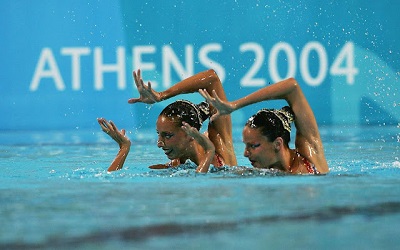
Water sport: water ballet
At its beginnings in 1892, the aquatic sport took the name of aquatic ballet; It would not be until 1933 that the name synchronized swimming would be appropriated, much less until 2017 that it would be renamed artistic swimming (we explain the details below).
1892 Yorkshire: When the first synchronized swimming event occurred

It is stipulated that the first synchronized swimming event occurred in 1892 in the Yorkshire city
Thus, In Yorkshire in 1892, right in the center of the United Kingdom, an event arose in a "scientific swimming" competition that was one of the requirements to be part of the Royal Lifesaving Society.
The ornamental or "scientific" swimming test was won at that time by a 14-year-old boy named Bob Derbyshire, after performing a series of flips into the water, a dive and other acrobatics.
1896 Greece First Olympic Games to include swimming

- To talk about swimming (NOT artistic) it is necessary to go back to the first Olympic Games of the modern era, held in Athens in 1896.
1907 New York: Who created synchronized swimming?

Who created synchronized swimming: Annette Kellerman 1907 Glass tank Hippodrome New York
First, it is worth mentioning that Annette Kellerman had a exquisite and innate grace in addition to possessing magnificent sporting skills.
In fact, in the face of his inert talents, Australian Annette Kellerman is credited with creating synchronized swimming by performing the first aquatic ballet in a glass tank at the New York Hippodrome in 1907.
Pioneer woman in swimsuits
On the other hand, it is also exciting to say that Annette Kellermann was one of the first women to wear a one-piece swimsuit, as opposed to pants that until then were authorized., even her swimsuits became so popular that she started her own fashion line.
Video Aquatic Ballet by Annette Kellerman
In 1908 the International Amateur Swimming Federation (FINA) was organized.

- La FINA was founded on July 19, 1908 in London, just when the 1908 London Olympic Games were about to end.
- THE International Amateur Swimming Federation was created by representatives of 8 national swimming federations: Germany, Belgium, Denmark, Finland, France, Hungary, the United Kingdom and Sweden.
1920 in different countries: Birth of synchronized swimming
The formation of aquatic figures takes the name of Ornamental Swimming.
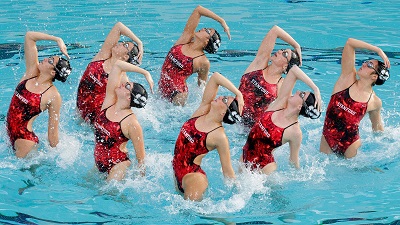
Origin and birth of artistic swimming (they made figures in the water), which occurs simultaneously in different countries: England, Canada, Holland, Germany, Belgium, France, the United States or Australia.
Peg Seller 1924 Canada: First winner of a synchronized swimming competition

First synchronized swimming champion: Peg Seller
In 1924, the first competition in North America was held in Montreal, Canada, with Peg Seller as the first champion.
However, many of the competitions of that time still took place in lakes, streams and rivers.
Additionally, in the 30s the first competitions took place in Germany, Canada and the United States.
Synchronized swimming pioneers
Other pioneers of the sport were: Beulah Gundling, Käthe Jacobi, Dawn Bean, Billie MacKellar, Teresa Anderson and Gail Johnson.
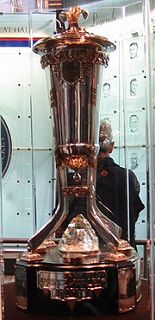
1926 Canada and Wales: National Figures and Styles Championship
Two years later (1926) the National Championship of figures and styles were held (also in Canada) and the Welsh Trophy, which they called Scientific and Full of Grace.
1933 Chicago show Modern Mermaids: When it became known as synchronized swimming

How was synchronized swimming created?
In consecuense, In 1933-1934 Katherine Curtis organized an aquatic ballet show, one of the most striking and impressive of that time, "The Modern Mermaids."
Synchronized swimming was called aquatic ballet
To this end, The news program promoted it for the first time by mentioning the aquatic sport as Synchronized Swimming and consequently it began to be known as Synchronized Swimming.
Synchronized swimming was accepted as a sporting exercise in 1941

Synchronized swimming: Admitted as a sports practice in 1941
However, synchronized swimming was not adopted as a sporting practice until 1941 by the United States Amateur Athletic Union.
In addition, the categories were divided between men and women, until then mixed categories., and it was also determined that the women's and men's categories would compete separately. Until then they could be combined.
1940 United States: the first regulations are drafted and Esther Williams spreads the aquatic sport

How synchronized swimming became popular
The importance of this aquatic exercise falls on the United States of America, a country where it gained popularity and significance with the films of Esther Williams, famous Hollywood actress and swimmer.
Actually, she is credited with being the great promoter of this water sport for shooting it to world fame thanks to her films from the 40s and 50s.
Thus, despite being much better known for her cinematographic role, Williams was one of the great protagonists of women's sports in the XNUMXth century.
Next, if you are interested, you can click and find out all the information about: Esther Williams, the siren of women's sports.

1952 Helsinki Games 1952: inauguration of synchronized swimming without distinction of gender
This was not the case before since in the Games de Helsinki 1952 It was when the category debuted without distinction of gender. Women and men competed to see who is the best in a sport that dates back to the late XNUMXth century, when it was known as "aquatic ballet«.
1955 Mexico Pan American Games: presentation of synchronized swimming as a competitive sport

The debut of Synchronized Swimming as a competitive sport occurs at the Pan American Games
of 1955, which, nothing more and nothing less, were in Mexico.
In 1955, Synchronized Swimming was officially accepted as a competitive sport at the Pan American Games, held in Mexico City.
1958 Amsterdam: first international synchronized swimming competition
The first International competition was held in Amsterdam, in 1958, under the direction of J. Armboust, president of the Synchronized Swimming Committee,
1964 Florida: Olympic champion Johnny Weissmulle contributed to the popularity of synchronized swimming
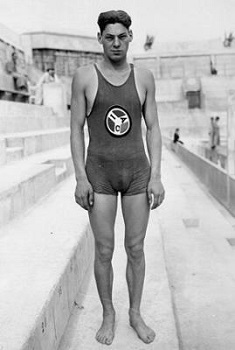
Johnny Weissmulle contributed to synchronized swimming fame
Likewise, the aquatic sport of synchronized swimming was not an exercise that will leave world swimming champions indifferent.
In response to which, the five-time Olympic champion, the American Johnny Weissmuller, part of the Billy Rose club, was in charge of popularizing the sport.
He was founding president of International Swimming Hall of Fame
The organization located in Fort Lauderdale (Florida) dedicated to promoting aquatic sports: competitive swimming, water polo, diving, open water swimming and synchronized swimming.
1973 Belgrade: The world swimming and synchronized championships begin to be held
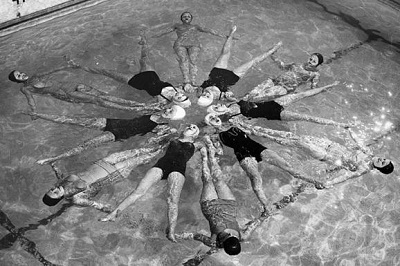
1973 World Swimming Championships
El I World Swimming Championships It was held in Belgrade (Yugoslavia) between August 31 and September 9, 1973. It was organized by the International Swimming Federation (FINA) and the Yugoslav Swimming Federation. A total of 686 athletes representing 47 national federations participated.
Swimming, synchronized swimming, diving and water polo competitions were held. The competitions were held in the Tašmajdan Pools in the Yugoslav capital.
1984 Los Angeles Olympic Games: Synchronized swimming becomes an Olympic exhibition sport
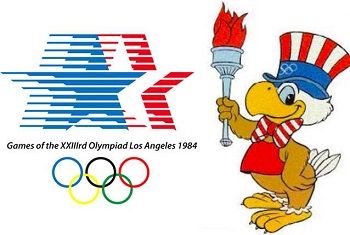
When did synchronized swimming become an Olympic sport?: at the 1984 Los Angeles Olympic Games
Finally, as we have already said before, Women's synchronized swimming became an Olympic sport at the 1984 Los Angeles Olympic Games, although When it was incorporated it was only accepted for women and with individual and couples events.
From another point of view, the rise of synchronized swimming was during the activity's debut as an Olympic sport in the 1984 Olympic Games.
For this reason, the already mentioned 'Hollywood mermaid (Esther Williams') was invited to the premiere as an Olympic sport in 1984 in Los Angeles to intensely promote the aquatic exercise of synchronized swimming.
It has been an Olympic sport since 1984. The competition is governed by the regulations of FINA (International Amateur Swimming Federation).
To the point that when it was incorporated as an Olympic sport in Los Angeles 1984 it was only accepted for women.
1988 Seoul Olympics: synchronized swimming becomes an official sport
Synchronized swimming as an official sport in the solo and duet modality.
2015 world swimming championships Kazan: Men's synchronized swimming

Men in synchronized swimming
Until a few years ago, only women were seen in synchronized swimming; in fact It was a solely female sport.. But in the world swimming championships Kazan in 2015 It was where men were seen competing for the first time, although only in the category of mixed duo.
Until they were able to participate in world, the men They could only compete in the United States and Canada, since both countries have own men's synchronized swimming team.
2017: Synchronized swimming is now named ARTISTIC SWIMMING
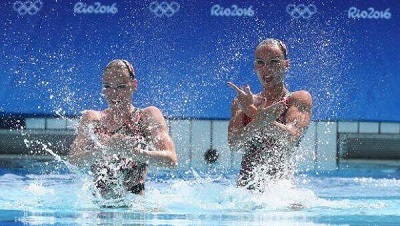
Likewise, in July 2017, with the approval of the national federations (but without much support from swimmers and technicians), synchronized swimming was renamed artistic swimming with the approval of the , but without much support from swimmers and technicians.
The name SYNCHRONIZED SWIMMING is now called ARTISTIC SWIMMING from the meeting of the FINA BUREAU held in July 2017 in Budapest, and will be put into practice from the 2017-2018 season.
Synchronized swimming is now history. Not this sport itself, of course, but its name.
However, it changes its name despite Russian opposition.
The congress of the International Swimming Federation (FINA) held these days has served to establish the new name of the modality: artistic swimming.
At the suggestion of International Olympic Committee (IOC), is now called that to stimulate its popularity and be equated with disciplines such as artistic gymnastics.
The word 'synchronized' has already been changed to 'artistic' in the FINA constitution and the same will happen from now on in all events, including the Olympic Games.
The decision will motivate "be a discipline better understood by the public and the media", according to the vice president of FINA, Sam Ramsamy, to the portal Inside the games.
Of course, there has not been an almost unanimous majority to support the implementation of the change.
Synchronized swimming Tokyo 2021: Russia revalidates synchronized team swimming

Russia wins team gold again and its dominance extends for 21 years
He has continuously won gold in this category since the 2000 Sydney Games.
- What is synchronized swimming
- General details of synchronized swimming
- Benefits of synchronized swimming
- Synchronized Swimming Chronology
- Origin and exclusion in men's synchronized swimming
- What is needed to practice synchronized swimming?
- How do you start synchronized swimming classes?
- Basic positions in synchronized swimming
- Basic movements in artistic swimming
- Types of competitions and exercises in synchronized swimming
- Synchronized swimming qualification
- Synchronized swimming with heels
- Synchronized swimming coloring pages
Origin and exclusion in men's synchronized swimming
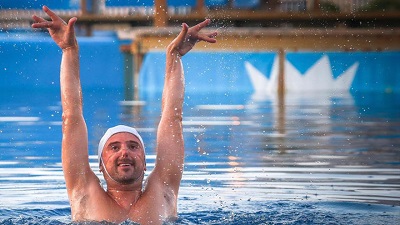
Origins of synchronized swimming: only for men
Synchronized swimming beginnings: especially for men
Synchronized swimming was designed to be practiced by both sexes, but the Athletic Union separated them because they thought that being a man had advantages in the water, but the truth is that it was the opposite.
In any case, alluding to the fact that male swimmers played a key role in the aquatic contests that became a very popular attraction among the public in the 30s and 40s.
And it was also determined that the women's and men's categories would compete separately. Until then they could be combined.
Why is there no synchronized swimming for men?
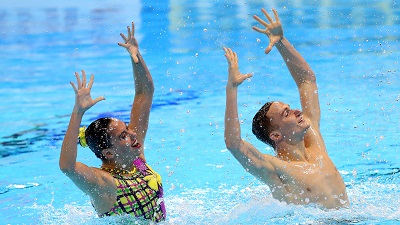
Synchronized swimming quickly became a sport for women only.
While in its beginnings it was a sport that was only practiced exclusively by men, it quickly became a female sport.
The point is that this separation took away the momentum of male contributions to the sport..
That idea was distancing men from this discipline not only in the United States, but also in other parts of the planet.
However, Nowadays almost all Olympic sports are practiced by both sexes, so it is possible that the option for male swimmers will be opened in the future, giving them room for choreographed and coordinated pirouettes in the pools at the Games.
On the other hand, the only option for the rules to change at the International Olympic Committee is for a FINA petition to be submitted three years before the next Games take place.
But it is even more hopeful, they point out, that with the opening of regional and continental tournaments to male participation, it has been possible to capture the attention of several men who now want to be part of synchronized swimming clubs in Europe and the United States.
A gold and a silver in the first synchronized world championship

Billy May first men's gold in synchronized swimming
After learning that the 2015 Kazan World Cup had admitted mixed duets for the first time in history, he did not hesitate: together with Christina Jones he was going to get gold in the technical routine and silver - only by a tenth of a difference - in routine free. Despite having been disconnected from swimming for more than a decade, he had managed succeed at the first opportunity.
2015 Kazan World Swimming Championships: First man winner in mixed duet in synchronized swimming

Men's synchronized swimming: first mixed duo gold in history
Below, video of the first male synchronized swimming winner, Bill May and Christina Jones won the first mixed duo gold in history for their impeccable technical performance at the 2015 edition of the FINA World Championships in Kazan.
The duo in synchronized swimming was ahead of Russia and Italy, who won the silver and bronze medals, respectively.
Enjoy watching her playful entrance and amazing timing skills!
Pau Ribes and his role in men's synchronized swimming

Pau Ribes is the pioneer of men's synchronized swimming in Spain, who started swimming at age 7. He greatly admired the great swimmer Gemma Mengual, and years later, their dream came true: Pau and Gemma were mixed duet partners. He was responsible for Gemma Mengual jumping into the pool again, after having retired from the competition.
Benefits of a mixed synchro team
The men in artistic swimming help to balance the playing field. A man on a women's synchronized swimming team contributes many values and benefits to the teamis complement very well and that makes everything turn out great.
Boys artistic swimming video
What is needed to practice synchronized swimming?

Requirements and basic equipment in Sincro
Two essential elements in synchronized swimming
At Synchronized swimming are used two very important elements: Una nose clip, It is used to prevent water from entering the nasal passages, in addition to a full piece swimsuit They have two key points for performance: comfort and design.
Equipment necessary to train in synchronized swimming
The equipment necessary to train is a swimsuit, a hat, diving goggles and the material to be used in training such as rubber bands, weights, etc.
The nose guard is essential: synchronized swimming clamps

What are grippers for water sports?
All the nostril forceps They aim to prevent water from entering the nostrils, and are of great help when swimming.
To clarify it a little more, the tweezers are essential to prevent water from entering the nostrils when making figures underwater, such as when performing a vertical position face down in the water.
In fact, swimmers usually wear clips and some spare parts under their swimsuit. Because if in the middle of the competition they fall (because when they swim so close together the bumps between them are very frequent), they quickly take out other clamps and place them under the water so they can continue the routine normally.
When should I use nostril clips in swimming?
- Basically, they are essential in synchronized swimming.
- In cWhen we start swimming and we don't master breathing, they are usually ideal for training in a more comfortable way., but they can affect your breathing technique, and this directly impacts your swimming efficiency.
- Therefore, an important point in swimming is learning to breathe and expel air correctly, so they can be a good tool for advanced swimmers, but try to avoid them for prolonged periods during your learning.
Advantages of using nostril clips in water sports
Pros of using nostril clips in pool sports
- In the first instance, they prevent water from entering your nose when you are learning swimming techniques.
- It works well for swimming in open water because it prevents certain microbes that live in these environments from entering.
- Another plus point is that they allow you to focus solely on your swimming technique and breathing through your mouth.
- Finally, if you are allergic to chlorine, these can help you avoid possible reactions.
Necessary equipment to compete in synchronized

As for the competition, what is necessary is to wear the competition swimsuit and also wear your hair up in a bun.
- For competitions, the costumes must be colorful and sometimes they are spandex, lace, sequins and PBT.
How to get a perfect bun in synchronized swimming
Why do swimmers put fish gelatin in their hair?
In order for swimmers not to be penalized, they must wear a bun and have a completely clear face and to fulfill that purpose there is nothing more effective than fishtail jelly.
Recipe for a perfect bun in artistic swimming
The recipe consistse in mixing the gelatin (they sell it in flakes or sheets) with hot water and the cold liquid is what is applied making a bow to prevent strands from coming off.
Truly, isinglass gelatin is often used in cooking.
In this way, to avoid having loose hair, athletes opt for a fishtail jelly, which is usually used for cooking.
Tutorial video to properly use the Synchronized Swimming jelly
Today we tell you how, once you have the perfect bun, to put on the Synchronized Swimming jelly.
How do you start synchronized swimming classes?

Conditions to start synchronized swimming
To start the Synchronized swimming, it is important to have a good knowledge of swimmingIt is also not unusual to see sport swimmers swimming synchronized after a few years.
What requirements must be met to start synchronized team swimming?
To join a synchronized swimming team you must take a simple exam to evaluate your ease and flexibility in the water.
You will also be asked for a medical certificate of no contraindication for the practice of synchronized swimming.
At what age should you start synchronized swimming?
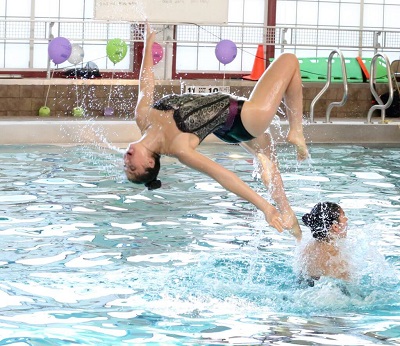
When can you start practicing aquatic ballet
To start practicing artistic swimming, it is advisable to wait a little longer than in the case of other sports disciplines because the little ones must master the aquatic environment, hence conventional swimming is the first step.
It is from the age of 6, 8 in some schools when they can start in this sport that allows them to develop flexibility, resistance, creativity, sense of rhythm, concentration and team spirit., Inter alia.
Recommended age for synchronized swimming
If age is not important when playing sports, it must be admitted that if you want to reach a certain level, compete, and reach the highest level, you must start as soon as possible. The ideal age to start synchronized swimming is between 6 and 10 years old.
Starting to practice Synchronized Swimming from a young age is the best.
This is how the physical and artistic abilities required to succeed in this tough and beautiful sport are developed.
How artistic swimming classes are oriented

The objective is to promote the sport in students who already know how to swim and create motivation to exercise in the pool.
- The program is very complete since there are stretching and dance classes plus a synchronized pool class.
- The duration of the class is usually half an hour on the ground and half an hour in the pool.
- The commitment to join a team is that you must complete the cycle of at least 3 months.
What is worked on in synchronized swimming
- The work of learning artistic swimming, once children know how to swim well, begins out of the water.
- With dry training, the little ones become familiar with basic positions of this discipline - platforms and jumps -, so it is a fundamental preliminary step so that they can know and control their body in the water, which is the second part of the learning process.
- To what they learned dryly, boys and girls will have to add knowledge of flotation and apnea, but this challenge is not undertaken until the basic issues described outside the water are mastered.
Artistic swimming routines are introduced in classes
- Solos – where an individual swimmer synchronizes to the music.
- Duets – where a swimmer coordinates with his partner and in time with the music.
- Team – where the swimmer coordinates with up to seven other athletes and in time with the music.
- Combination – a team routine where up to ten swimmers perform in a continuous routine, but during the routine there will be segments where different numbers of swimmers perform.
It also involves learning competition routines.
In most senior meets, swimmers perform two routines for the judges, one technical and one free.
- La technical routine involves the completion of predetermined elements that must be executed in a specific order. The free routine It has no requirements, so swimmers can be “free” in terms of their creativity with the movements and their choreography.
Levels in artistic swimming

There are 5 levels in synchronized swimming
There are 5 levels (Beginner, Developmental, Intermediate, Performance and Mastery), each subdivided into grade and age categories. The first three consist of regional and provincial competitions, while the other two are provincial and national.
Approximately one level is gained in synchronized swimming every 2 years of training
On average, a swimmer rises every 2 years. The higher the level, the more difficult the skills will be to perform and the more training hours will be increased.
- What is synchronized swimming
- General details of synchronized swimming
- Benefits of synchronized swimming
- Synchronized Swimming Chronology
- Origin and exclusion in men's synchronized swimming
- What is needed to practice synchronized swimming?
- How do you start synchronized swimming classes?
- Basic positions in synchronized swimming
- Basic movements in artistic swimming
- Types of competitions and exercises in synchronized swimming
- Synchronized swimming qualification
- Synchronized swimming with heels
- Synchronized swimming coloring pages
Basic positions in synchronized swimming

Most used figures or positions
In synchronized swimming, there are about twenty basic positions, which are combined to make the figures of the free and technical routines.
This discipline is understood by various positions or basic figures, which are considered a fundamental point of synchronized swimming. From these, the competition routines are developed and must be developed in the best possible way.
Below we explain the most basic positions that are learned in the first years of initiation to synchro.
Once all the most basic positions are controlled, you can increase the level and even innovate with new movements.
- Stretched: performed on the back and face down with the body fully stretched.
- Ballet leg: this position can be performed on one leg or two; It also takes place on the surface of the pool or within the depths.
- Vertical: with respect to the stretched position, this is executed vertically. The rest of the figure has the body located fully extended.
- Front and back tent: In both tent positions, the body must be flexed at the hips.. From the front, the angle is 90 degrees and from the back, the flexion increases to 45 degrees. The rest of the body must remain aligned.
The basic positions and transitions are combined to perform the figures and free and technical exercises.
1st Stretched back position
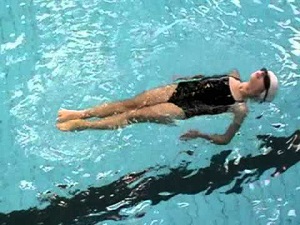
Body extended, with face, chest, thighs and feet on the surface of the water. Head (at ear level) in line with hips and ankles.
2nd Front stretched position
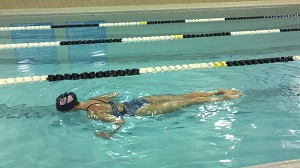
Body extended, with head, upper back, glutes and heels on the surface. The face can be in or out of the water. The idea is that the swimmer shows the judges most of her body outside, as if it were a line.
3rd Position ballet leg
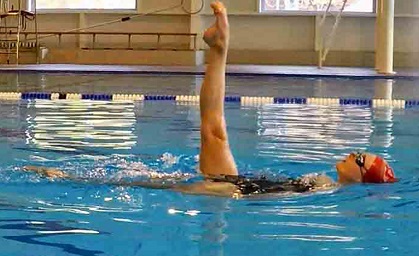
- On the surface: body in a stretched position on its back. One leg extended perpendicular to the surface.
- Inside the water: head, trunk and leg horizontal, parallel to the surface. One leg perpendicular to the surface, with the water level between the knee and ankle.
4th Position flamenco
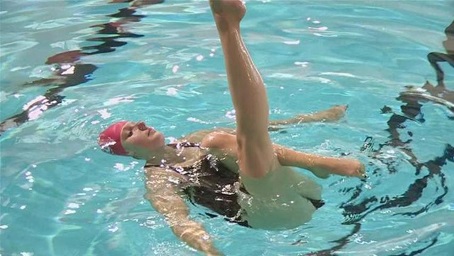
- On surface: one leg extended perpendicular to the surface. The other leg bent forming a 90º angle, mid-calf against the vertical leg, foot and knee on the surface and parallel to it. Face on the surface.
- Inside the water: trunk, head and shin of the leg bent parallel to the surface of the water. 90º angle between the trunk and the extended leg. Water level between the knee and ankle of the extended leg.
5th Double ballet leg position

- On the surface: legs together and extended perpendicular to the surface. Head aligned with the trunk. Face on the surface.
- Inside the water: trunk and head parallel to the surface. 90º angle between the trunk and extended legs. Water level between knees and ankles.
6º Vertical position
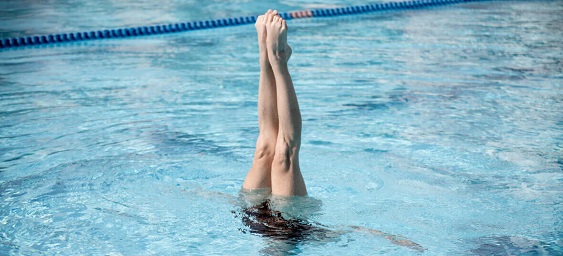
- Body extended perpendicular to the surface, legs together, the entire body should be in one line.
7th Crane Position
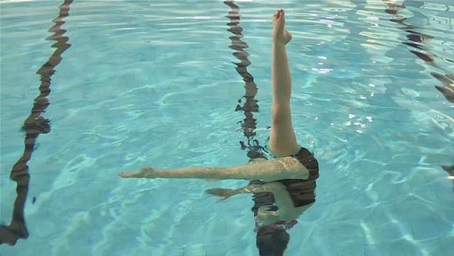
- Body extended in a vertical position, with one leg extended forward, forming a 90º angle with the body.
8th Fishtail Position

- Same as the grunt position, except that the foot of the front leg has to be on the surface, regardless of the height of the hips.
9th Shrunken Position

- Body as compact as possible, with rounded back and legs together. Heels close to the buttocks. Head pressed to the knees.
10th Front tent position

- Body flexed at the hips, forming a 90º angle. Legs extended and together. Trunk extended with back straight and head aligned.
11th Back tent position

- Body flexed at the hips forming an acute angle of 45º or less. Legs extended and together. Trunk extended with back straight and head aligned.
12º Arched position in dolphin
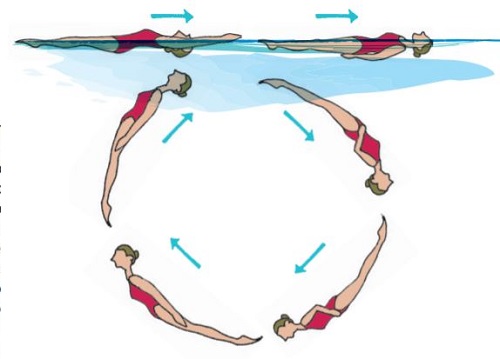
- Body arched so that the head, hips and feet imitate the shape of a bow. Legs together.
13th Surface arch position
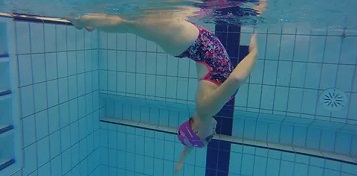
- Lower back arched, with hips, shoulders and head aligned vertically. Legs together and on the surface.
14th Position with one knee bent
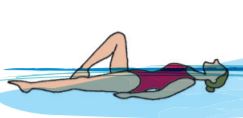
- The body can be in a back-stretched position, a front-stretched position, an upright position, or an arched position. A bent leg, with the big toe touching the inside of the extended leg at the knee or thigh. In the back straight plank and surface arched positions, the thigh of the bent leg should be perpendicular to the surface of the water.
15º Barrel position

- Legs together and bent, feet and knees parallel to the surface, and thighs perpendicular to it. Head aligned with the trunk and face on the surface.
14th Spagat Position

- Legs evenly spread, one front and the other dorsally, with feet and thighs on the surface. Lower back arched, with hips, shoulders and head in a vertical line.
17. Knight position

Lower back arched, with hips, shoulders and head in a vertical line. One leg vertical and the other extended dorsally, with the foot on the surface and as close to the horizontal as possible.
18. Variant knight position
Lower back arched, with hips, shoulders and head in a vertical line. One leg vertical and the other behind the body (extended dorsally) with the knee bent at an angle of 90º or less. The thigh and calf will be parallel to the surface of the water.
19. Side fishtail position

Body extended in a vertical position with one leg extended laterally and its foot on the surface regardless of the height of the hips.
20. Straight head out of water position
body more or less at the height of the breasts out of the water and making some movements with the feet.
Basic movements in artistic swimming

1st basic movement in artistic swimming
Adopt a ballet leg

- You start in a stretched position on your back. One leg remains on the surface the entire time. The foot of the other leg slides along the inside of the extended leg, until reaching the bent knee position. The knee is then stretched, without producing any movement in the thigh, until reaching the ballet leg position.
2nd Basic movement in artistic swimming
Final movement from the arched position to the back stretched position

- From the arched position on the surface, the hips, chest and face emerge sequentially at the same point, with a movement towards the feet, until the extension/back position is reached and ending when the head occupies the position it had. the hips at the beginning of the movement
3nd Basic movement in artistic swimming
Countercataline rotation

- From the crane position, the hips rotate while the trunk ascends with lateral movement
- until adopting the ballet leg position. Throughout the rotation the legs maintain a 90º angle between them.
4nd Basic movement in artistic swimming
Giros

- A spin is a rotation at a sustained height. The body remains on its longitudinal axis throughout the rotation.
- If not indicated otherwise, it is done in a vertical position. A turn is completed with a vertical descent.
- Half turn: a 180º turn
- Complete turn: a 360º turn
- Quick half turn: a quick 180º turn
5nd Basic movement in artistic swimming
Downward turn
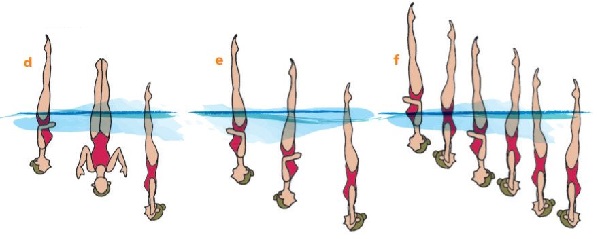
- A downward turn is a rotation in an upright position. The body remains on its longitudinal axis throughout the rotation. Unless otherwise specified, turns are executed at a uniform pace.
- 180º downward rotation
- 360º downward rotation
- Downward and continuous rotation
- Rapid rotation of a minimum of 720º, which is completed before the heels reach the surface of the water and continues until the feet are completely immersed.
6nd Basic movement in artistic swimming
Dolphin
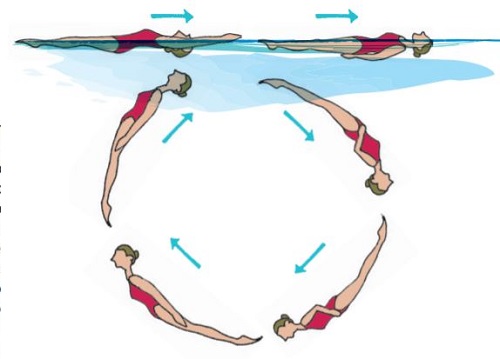
- A dolphin (and all its modifications) starts in a stretched position on its back. The body follows the circumference of a circle that has an approximate diameter of 2.5 meters, depending on the height of the swimmer. The head, hips and feet are submerged sequentially until reaching the arched dolphin position, while the body moves around the circle with the head, hips and feet following the imaginary line of the circumference.
- The movement continues until the body begins to stretch (straighten) as it emerges into a back-stretched position, with the head, hips, and feet breaking the surface at the same point.
7nd Basic movement in artistic swimming
vertical dolphin

- When the head reaches the point marked by the first quarter circle through a continuous movement, the body straightens while continuing to descend until it reaches the vertical position. The toes reach the point of the first quarter circle at the precise moment they reach the vertical line.
- Maintaining the vertical position, the body ascends along its longitudinal axis until a water level is established between the ankles and hips.
Basic rows in synchronized swimming
Video Basic rows in synchronized swimming
Explanation of basic rowing in synchronized swimming or artistic swimming:
- flat row
- Standard row
- Rowing against standard
- Torpedo paddle
- Contratorpedo paddle
- American rowing
Body position in each synchronized swimming stroke, basic tips and errors.
Synchronized Swimming Tips: Entry and stability in the tent
Synchronized Swimming video tips: Entry and stability in the tent
The tent entry is one of the most important basic movements in artistic swimming and that is why it is important to learn to master it well because it will accompany you throughout your career. If you don't learn it well, you will always have that Achilles heel where you will have problems because it is used in all categories.
Synchronized Swimming Tricks Video: Verticals with Angles
This article on the vertical with angles is for an advanced level of Artistic Swimming, but also for those who want to try and be inspired for the future.
Types of competitions and exercises in synchronized swimming

Regional and national level
There are several types of competitions, if we start with the most basic ones we find:
- that regional and national level passes. Both have the same type of tests, both in the water and out of the water (yes, swimmers are also tested out of the water), although the national level is a little more demanding.
- Next we have the league of figures, which is celebrated on different dates. The scores are averaged and medals are awarded. Generally in these competitions there are 4 panels in which a different figure is performed in each of them. 2 figures are mandatory and are always the same, and the other 2 go to a draw which is held by the Federation days before the competition.
- Once we have finished with the figure competitions, we start with the figure competitions. routines: promotion, absolute and autonomous; each of them with their requirements and characteristics that differentiate them.
- And finally (at the national level) we have the Spain Championship, where the swimmers perform 4 figures (2 mandatory and 2 by draw, as in the figures league) and on the other hand compete in the routines modality.
Synchronized swimming exercises during competitions

Technical and free routines in synchronized swimming
Routine competitions can be diverse. We talk about free routines and technical routines. The techniques require a limited number of figures marked by the regulations, in a certain order and within a time limit. What the judges score the most is the technical quality, since it is more important than the artistic quality, in this case.
In the case of free routines, choreography is performed to the rhythm of music. The swimmers have total freedom to incorporate movements and give a personal and artistic touch.
Swimmers create routines by doing combinations of basic positions, called figures. In their programs, athletes use creative transitions to move from one side to the other in the pool. Thus, they take the opportunity to catch their breath after the figures they have made underwater.
1st part of the competition: Technical routine
In this first part, the swimmers perform a limited number of figures. They must make the figures in a certain order and within a certain time limit. In the individual tests, they have 2 minutes to make 6 figures; in duos, 2.20 to make 7 figures; and in team exhibitions, 2.50 to make 8 figures. In this test, technical quality points are more important than artistic quality points. The technical routine represents 35% of the final score in the competition.
2nd: Free routine
In this second part, the athletes add personal and artistic touches to their programs, as they prepare their own routines. Swimmers typically start poolside; They have up to 10 seconds to enter the water. In this test, points for artistic quality are more important than those for technical quality. The free routine represents 65% of the final score in the competition.
What are the categories of synchronized swimming?
Type of routine according to the number of swimmers
They can be alone, in which only one swimmer participates individually. In duets, two swimmers participate. A minimum of 4 swimmers and a maximum of 8 swimmers participate in the teams. And finally we have the combos, which only compete in free mode. This groups all the previous ones, that is, there can be a team, three swimmers, duos, solos... within the same routine, and a maximum of 10 swimmers compete. On the other hand, there are highlights, in which swimmers can use material to perform the routine, but this modality does not enter into competition.
Individual or alone

Swimmers create exercises or "routines" by doing combinations of basic positions and transitions, called figures. In their performances, they use creative transitions to move from one side of the pool to the other, since the exercises must be done while covering its entire length.
singles: two minutes to do seven required items
Duets

Duets require perfect synchronization with the music and require excellent coordination of the two swimmers. In the free routine, athletes are not required to perform the same figures at the same time, but their movements must be artistically coordinated. Duets require perfect coordination of the two swimmers, as well as good synchronization with the partner's body. In the free routine, they are not required to perform the figures at the same time, but their movements must be artistically coordinated. It is allowed to carry your partner. The duet can be appreciated more than the solo since they have coordination from the first moment the music starts.
Couples: two minutes and twenty seconds to make nine items
Equipment displays
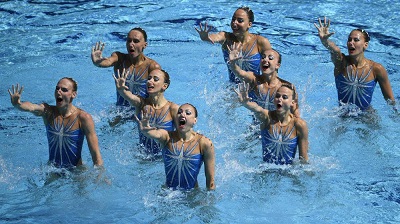
Four to eight participants In the free routine, the athletes must be perfectly synchronized even if not all of them are performing the same figures. Coordinating the movements of so many swimmers is difficult: it requires many hours of training.
Composed of eight participants, they must act with perfect synchronization even if they do not all perform the same figures. Team performances require many hours of training. In official senior competitions they must perform a technical exercise and another free exercise.
Groups: three minutes to make 19 elements and at least one formation in a straight line and one circular.
Combo or free combination
It is another type of synchronized swimming. It is the same as the team modality but includes individuals and solos, that is, in the same choreography the swimmers swim all together, then one alone, or two alone, or three..., and so on, then all together again.
Synchronized swimming qualification
Synchronized swimming and its rules

Who governs the rules of artistic swimming
Currently, Synchronized Swimming worldwide is governed by the regulations of the International Swimming Federation (FINA).
All international synchronized swimming championships are organized by FINA (International Swimming Federation), and those held in Spain are organized by RFEN (Royal Swimming Federation).
How many judges are there in synchronized swimming?
While 10 jueces As all the movements follow, swimmers must perform grueling series of lifts, lifts, spins and twists, all without touching the bottom of the pool.
What are the rules of synchronized swimming?
Synchronized swimming rules
- There are three type of competitions Synchronized swimming: singles, duos and team exhibitions.
- The competition is divided into: technical exercise and free exercise.
- The judges assess the technical and artistic quality of both routines, and can award a maximum of 10 points in total.
- In both duet and team competitions, swimmers have to perform two routines: technical routine and free routine.
- Teams must complete two routines and in the Olympic Games are only for women. First of all, the technique includes five designated figures with a maximum duration of two minutes and 50 seconds. Secondly, the spirit It is 3 to 4 minutes. Both must use music (that they can listen to underwater).
- To obtain victory in this exciting discipline, competitors must achieve the highest score, which se obtained by making figures synchronized in two parts, a technical side and a free side.
- Depending on the category and age, the type of exercise varies for the swimmers: The competition, or competition, for swimmers in the junior category and all competitors (over 15 years old) is divided into two parts: technical exercise y free exercise. The judges score the technical quality, grace, delicacy, artistic creation in synchronization with the music of both exercises; Likewise, the strength, height of each figure and its respective attitude (artistic expression) are verified with a maximum of 10 points. Athletes may be penalized if they touch the bottom of the pool, lean on the edges, show signs of fatigue and do not present any grace or smile.
Video Basic rules of Synchronized Swimming
Fundamental regulations for synchronized swimming
Synchronized swimming penalties

Prohibited movements in synchronized swimming
As such there are no prohibited movements, But there are several aspects that points are subtracted in a competition.
Artistic swimming exercises are penalized with half a point if:
- And half a point for each competitor who omits a part of an element.
In synchro exercises, one point will be subtracted if
- They exceed 10 seconds for movements out of the water.
- The total time of the routine is exceeded.
- There is a deviation from the allowed time limit.
- And one point for each part of a mandatory element that not all competitors perform.
Two points will be deducted in artistic swimming if:
- A competitor makes use of the pool floor.
- A competitor interrupts the competition during movements out of the water and is allowed to start again.
- In technical routines, two points will be subtracted from the performance grade for each mandatory element that is not performed.

Although there are a number of rules and penalties for specific routines, the basic rules of synchronized swimming are shown below.
- Don't touch the bottom: One of the things that makes lifts even more impressive is that synchronized swimmers are not allowed to touch the bottom of the pool at any time during their routines.
- No appraisals: Performing is a unique and important part of synchronized swimming, but there are certain restrictions on what swimmers can wear. For example, synchro swimmers are not allowed jewelry, theatrical makeup, or inappropriate costumes.
- Without glasses: Another restriction during synchronized swimming routines are goggles. However, swimmers in figure competitions can use them.
- Team Means Team: Teams normally contain eight swimmers, but the minimum number for a team is four. Teams lose points for each swimmer they have under full complement because it is easier to synchronize the fewer people in a routine.
- Stick to a time: Routines can last from two and a half minutes to five minutes, depending on whether they are performed alone or as part of a team. However, swimmers are penalized if they take 15 seconds less or more than the specified time. The time to perform the technical and free routines, both in duet and as a team, already includes ten seconds for movements outside the pool. And there is 15 seconds more or less tolerance on the times allowed for routines.
- Within the rules, they cannot be out of the water for more than ten seconds y You cannot touch the floor of the pool or its edges. Yes, they can choose the music and as far as costumes are concerned, this cannot include transparency.
- Is totally prohibido that the swimmers touch the bottom of the poolIf someone touches, the judges must penalize the entire team. The swimsuit should not have transparent fabric. Any of these penalties in a competition can be decisive.
The scoring criteria
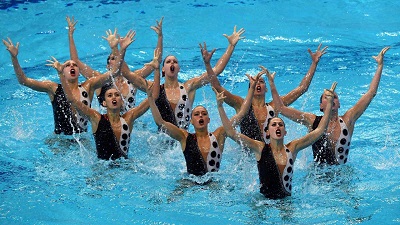
The judges give their qualification of the routines, taking into account the aspects that they must evaluate during the development of the competitions in accordance with the criteria that FINA has established and that we will see below.
The score of each participant is defined by two panels of judges, composed of five or seven people. In the technical routine, one panel evaluates the execution—completion of the mandatory parts—and another the overall impression.
In the free routine, meanwhile, one panel looks at technical merit—aspects such as timing and difficulty—and another at artistic impression. For this last point, issues such as choreography and musical interpretation are considered.
In both routines The score ranges from 0 to 10 and certain actions can be penalized, such as exceeding 10 seconds out of the water. All swimmers start from 10, and points are deducted as they make mistakes.
How is synchronized swimming scored?
How is synchronized swimming scored in the technical routine?

synchronized swimming score in the free routine

Synchronized swimming with heels

Russian synchronized swimming champion Kristina Makushenko defies physics in heels
Russian synchronized swimmer Kristina Makushenko has become a TikTok star thanks to videos in which she demonstrates his impressive skills, often with unconventional high shoes for sports practice.
Afterwards, you can click to learn all about: underwater queen in heels: a Russian synchronized swimmer conquers TikTok
Synchronized swimming champion walked 360º underwater
Synchronized swimming coloring pages
Synchronized swimming images to color online
Next, in this link, we leave you a drawing to color with your computer: synchronized swimming duo.
Download synchronized swimming coloring pages
